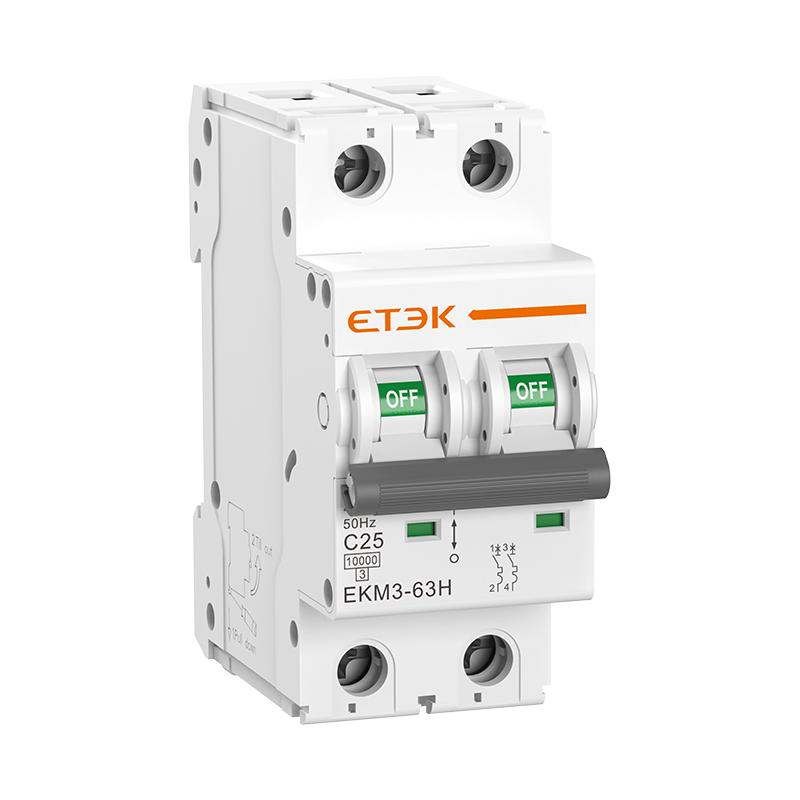How to choose the right miniature circuit breaker?

What Is Miniature Circuit Breaker?

Example of internal structure of EKM3-63 circuit breaker
Miniature circuit breaker, also known as Micro Circuit Breaker (MCB), is the most widely used terminal protection appliance in building electrical terminal power distribution devices.
It is used for single-phase and three-phase short circuit, overload and overvoltage protection below 125A, including single-pole 1P, two-pole 2P, three-pole 3P, and four-pole 4P.
It can also be used for infrequent operation switching of the line under normal circumstances. The product should comply with IEC60898-1 or IEC60947-2 standard.
What does a miniature circuit breaker do?
Miniature circuit breakers (MCBs) ensure electrical safety in homes, offices and other buildings as well as for industrial applications by protecting electrical installations against overloads and short circuits.
Once a fault is detected, the miniature circuit breaker automatically switches off the electrical circuit to prevent damage to wires and to avoid the risk of fire.
What kinds of tripping mechanisms does the MCB have?
Warranting reliability and safety for people and assets, MCBs are equipped with two tripping mechanisms:
1. the delayed thermal tripping mechanism for overload protection and
2. the magnetic tripping mechanism for short circuit protection.
What are the benefits of a miniature circuit breaker?
1. The rated short-circuit breaking capacity is high, and some rated current levels can reach more than 10KA.
2. Double wiring function, can easily connect standard bus bar and flexible wire.
3. Combination terminal with finger touch protection, higher safety.
4. It is operated by an energy storage mechanism, and the contacts are quickly closed, which overcomes the adverse effects caused by the speed of manual operation of the handle and improves the service life of the product.
5. A variety of accessories are available, and the modular and flexible combination is very convenient for users to install.
6. The shell and some functional parts are made of high flame retardant, high temperature and impact resistant materials.
7. The current limiting coefficient is high, and the performance-price ratio is superior.
How to choose a miniature circuit breaker?
In civil building design, low-voltage circuit breakers are mainly used for line overload, short-circuit, over-current, voltage loss, under-voltage, grounding, leakage, automatic switching of dual power sources, and protection and operation of motors during infrequent starting.
In addition to complying with basic principles such as the use environment characteristics of low-voltage electrical equipment.
What is the most important consideration in selecting a MCB?
1.Rated voltage
The voltage value of miniature circuit breaker when working, and the rated voltage of miniature circuit breaker shall not be lower than that of circuit.
2.Rated current
Rated current is the maximum current value that the circuit breaker can withstand without tripping.
First, you should determine the total current of the circuit.
Then, you should select the proper MCB.
The current rating of MCBs should not be greater than the cable current carrying capacity. It should also be greater than or equal to the maximum current that the system is expected to carry.
Do not use an MCB lower than the total current of the circuit. Otherwise, it trips unnecessarily.
3. Tripping characteristics
The tripping characteristics define the relationship between the current and the tripping time. They are distinguished according to the instantaneous tripping range.
What are the types of commonly used circuit breakers according to their tripping characteristics?
Commonly used circuit breakers are generally divided into three curves: B, C, and D. You should determine the tripping level according to the load to be protected.
1. B curve
Designed for cable protection, is suitable for resistive loads such as electric heating, water heaters and furnaces, as well as long cable runs (fault loop impedance).
2. C curve
Designed for industrial and commercial circuits, is suitable for protecting distribution lines, lighting lines and motor circuits with high connection currents
3. D curve
Specially designed for heavy equipment used in industry, suitable for protecting equipment with large inrush current, such as transformers, solenoid valves, etc.
4. Breaking capacity
The rated short-circuit breaking capacity of the miniature circuit breaker is greater than or equal to the maximum short-circuit current that may occur in the line.
High currents above the breaking capacity may damage the MCB.
5. Number of poles
Determine the number of poles of the miniature circuit breaker according to the number of lines to be protected.
For example, general household electricity is single-phase, and the line consists of neutral and live lines.
If both lines need protection, the circuits breaker with two poles is selected; if the neutral line does not need protection, the one pole circuit breaker is selected.
Conclusion
A miniature circuit breaker is a device that interrupts an electric current. It works by detecting overcurrent in the electrical system and breaking the connection to prevent damage to the equipment or fire.
If you are looking for a reliable and durable miniature circuit breaker, ETEK Electric offers MCB for various applications.
Welcome to consult and contact us, we would be happy to help you find the perfect product that can meet your needs.





.jpg)





